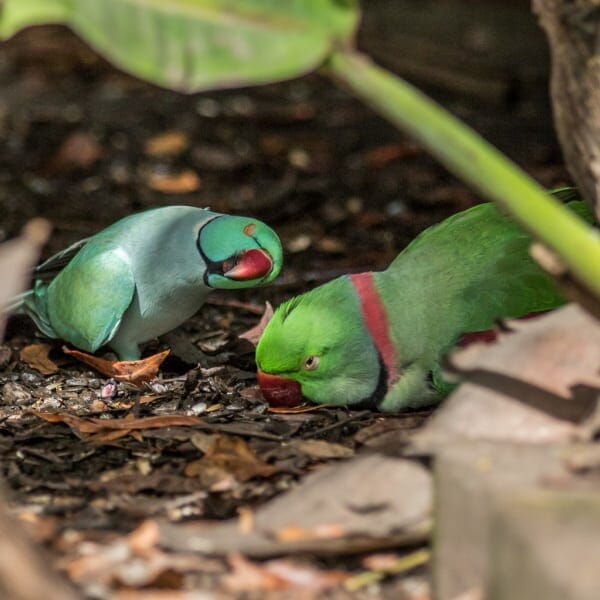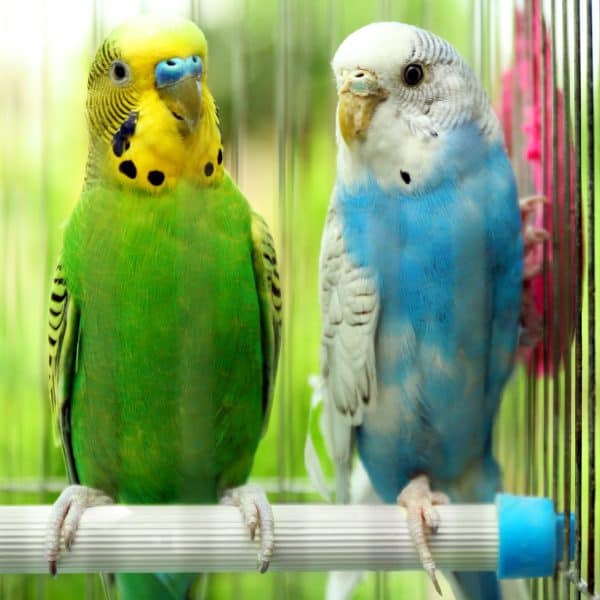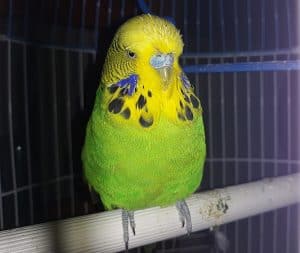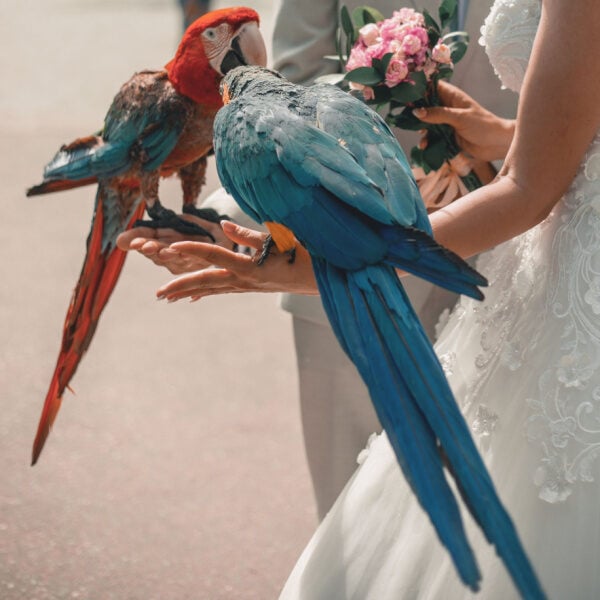Last Updated on by Mitch Rezman
Indian ringnecks are marvelous birds and I’ve had the great fortune to live with the species in two different households.
They’re not big birds they weigh an average of 115 g about the body size of a Senegal or a fat cockatiel but the long tail gives the impression that it’s a much larger bird.
The overall length of the bird must be taken into consideration when choosing the right birdcage and especially the travel carrier.
They can be quite tame and are a relatively good talker.
Below you will find three curated questions about Indian ringnecks that found us one way or another and we felt sharing solutions would be helpful.
In a former life, another movie, I was a dog guy.
10 years of malamutes and Huskies.
15 years of standard poodles.
Sometimes divorce sends you adrift.
Conversation with a ringneck ~ video
In my case, I drifted into a household of 2 children and 3 parrots.
Cherry-headed conure, white-capped pionus, and a Lutino (yellow) female Indian ringneck.
At some point, I realized I needed to move forward.
The glue that bonds our disjointed life experiences is too cosmic to explain.
I met Catherine in the spring of 2002.
By the end of that summer, I was thoroughly ensconced in her life including Sunshine and Honey her TWO Indian Ringnecks.
Honey the female could care less about any “being” other than Sunshine, her “boy toy”.
Sunshine was a case of unrequited love with Catherine and miserable with Honey.
Catherine made the rational decision to introduce Honey back into a breeding program enabling her to focus on Sunshine as a pet.
Sunshine was a trip.
He had a few phrases he would speak like “nummy, nummy” in the same sweet voice that all Indian Ringnecks have.
He loved her feet.
Sunshine went across the rainbow bridge one summer afternoon having suffered a stroke at the age of 20.
He set the bar for keeping birds in our home.
Editor’s note: Indian ringnecks, are the national bird of India and are not allowed to be held captive.
[email protected] replied
Hi Mitch,
I’m at a loss with my IRP. She will be 5 in May.
She has started hormonal behavior and she is way out of control.
I’ve read a few articles on what to do and what not to do.
She has been in attack mode for more than a month. If anyone comes over she attacks them.
She will come to me just to attack, then wants me to rub her head as I would normally do, then she attacks again.
I’m so upset, we use to be best friends.
Keto our rescue African
ringneck saying “pretty bird” to his friend ~ Video
I just purchased a light from your website thinking this would help.
I talked to the vet and he said just leave her in the cage.
Editor’s note: Vets are usually more helpful.
I brought her to the vet this past Friday to get her wings trimmed. I thought that would slow down her behavior, but it hasn’t.
I’ve been bit several times in the last month and I’m not sure how much longer I can take it.
Do you have any suggestions?
First things first, Crystal.
To help control hormonal behavior the light needs to be on a timer set for 12 hours on 12 hours off sometime between seven and nine each day and evening.
The light must be no higher than 6 inches over the cage.
The bird must be in the cage when the light turns off at night and on in the morning.
That is the first thing we will do to help reset your Indian ringneck’s circadian rhythm which is a major hormonal trigger.
Here I go knocking heads with veterinarians.
Keeping the bird locked in the cage gives it a sense of being in a confined area and reinforces the bird’s need to breed, so let her out of the cage.
Clipping of any bird’s wings does nothing to reduce hormonal behavior.
A flighted bird will exhaust calories in flight and a bird that has exercised will be less hormonal.
Are there hormonal triggers such as sleep sacks or boxes under a couch which promote any area to be a nesting area?
I would need to know more about the diet.
If the diet has any soy in it I would find a soy-free base diet like Hagen Tropican Alternative Parrot Granules.
We are finding that soy may trigger hormonal and behavioral issues
Does the bird have a lot of foraging opportunities to take her mind off of making babies?
Does she have lots of things that she can chew up?
If you see no changes in the behavior after two weeks with the 12 on 12 off light cycle email me back and were going to talk about the 72/168 hour consistent light treatment as well as other things that can be done
Best
Mitchr
Should I be concerned after my green parrot lost her egg?
Indian green parrot couple.
Laid their first egg.
Raani had been sitting on her egg for days until one day it disappeared.
Continues to sit inside the box.
Does she want to lay another?
Has looked dazed every since started nesting.
Yesterday I placed a chicken egg, she’s been sitting on it.
Mistake?
I’m assuming they are Ringnecks?
If this is the case, given that ringnecks typically lay 3 to 6 eggs per clutch (usually every other day)
I would surmise She is egg bound based upon your description of her. I would advocate a trip to the vet ASAP to check out her reproductive system.
Remove the chicken egg as it is only promoting brooding activity which the bird is clearly not for currently.
[email protected]
I have a year old female ringneck, at first she only nipped at my finger when I’d put my hands near her food but now she launches a bite at me randomly even while she’s on my shoulder.
When she was younger she used to love to cuddle up with me under the blankets however now if my finger or face gets too close to her while she’s under the blankets she goes psycho and bites me.
Why is she now starting to bite even while on me?
Hi April
Your bird is now a sexually mature creature and you are treating her like a toy. She does not belong in bed with you and under the covers.
She is a bird. You are confusing her and she is hormonally charged and you can’t give her what she wants or needs. She needs to be in a cage.
Got it. She has a cage and sleeps in it every night but I like to let her roam free.
Are there any solutions to solving this issue without having to buy a male bird?
Dear April
Your bird is hormonal and needs to not be.
She should have a full spectrum light put above her cage (12 inches away is fine), the light should be on 12 hours and off 12. Figure 8 am to 8 pm.
That will help keep her hormones level.
She should only be pet from the neck up.
Below the neck is sexually stimulating.
No more in bed with you.
No birdie beds or tents.
If she starts to masturbate or lay eggs then you can give her a simple light treatment that will stop that behavior.
She would be kept in her cage for 72 hours with the LIGHT ON.
Not turned off for three solid days and nights
(She can be out and about during the day, but in the evening and night, she goes back in the lit-up cage)
This will reset the circadian rhythm in her body and brain and she will lose interest in broody behavior.
Yes, she will be able to sleep in the light but may chirp at midnight in confusion. It will not harm the bird.
Then go back to 12 hours light on and 12 hours light off.
This should help.
Catherine
Author Profile
Latest entries
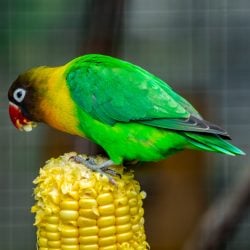 Feeding Exotic BirdsJune 20, 2025Is Corn On the Cob Safe for Pet Birds?
Feeding Exotic BirdsJune 20, 2025Is Corn On the Cob Safe for Pet Birds? Bird & Parrot AnatomyJune 19, 2025Would You Like a Comprehensive Guide for Training Your Bird?
Bird & Parrot AnatomyJune 19, 2025Would You Like a Comprehensive Guide for Training Your Bird?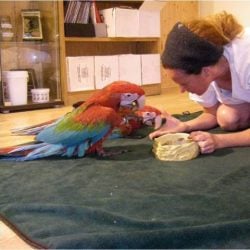 Feeding Exotic BirdsJune 19, 2025Here Are Three (Video) Strategies to Help Your Bird Forage
Feeding Exotic BirdsJune 19, 2025Here Are Three (Video) Strategies to Help Your Bird Forage Bird BehaviorJune 13, 2025Why Do Some Parrots Struggle in Captivity?
Bird BehaviorJune 13, 2025Why Do Some Parrots Struggle in Captivity?
